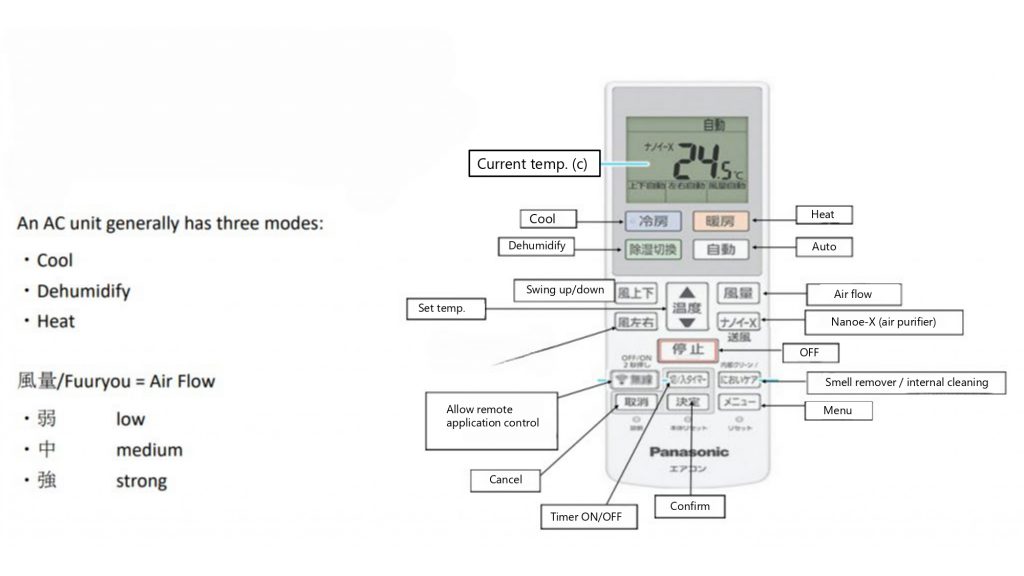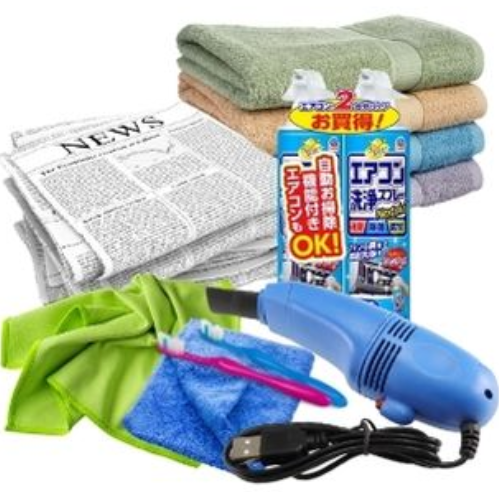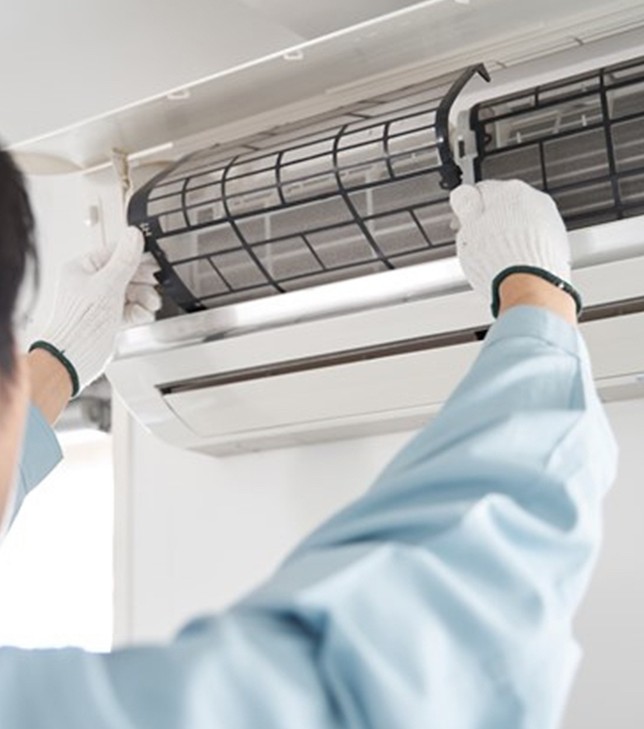Using Japanese Air-Conditioners (エアコン or eakon) effectively is essential for surviving swelting Japanese summers. Below is Relo Japan’s complete usage guide for mastering the Japanese “eakon” in summer, preventing mold build-up while using them and tips for energy conservation.
Cool vs Dehumidify: What’s the Difference?
Cool Mode (冷房 – Reibō)
- Use for: Lowering the room temperature quickly, severe hot weather
- Electricity Use: Medium consumption, can increase if using for long periods with very low temperatures
Dehumidify Mode (除湿 – Joshitsu)
- Use for: Removing moisture in the air, maintaining reasonable temperatures after cooling room down from Cool Mode
- Electricity Usage: May use less than cool mode
Using your remote

| JAPANESE | ENGLISH | FUNCTION |
| 冷房 (Reibō) | COOL | Cooling Mode |
| 除湿 / ドライ (Joshitsu / Dry) | DEHUMIDIFY | Dehumidify Mode |
| 暖房 (Danbō) | HEAT | Heating Mode |
| 送風 (Sōfū) | FAN | Fan Only |
| 自動 (Jidō) | AUTO | Automatic Mode |
| 運転 / 停止 (Unten / Teishi) | ON/OFF | Power |
How to clean your wall-mounted air conditioning unit
Video:
Required Items:
- Air conditioner cleaning spray (available at drugstores or online)
- Towels and newspapers
- A soft cloth or toothbrush
- Optional: vacuum
Step-by-Step Cleaning Process
- Turn off and unplug the unit.
- Open the front panel and remove the filters.
- Vacuum the dusty side of the filters.
- Wash the filters with water and gently scrub.
- Dry the filters (avoid direct sunlight or hair dryers).
- Spray the inside of the unit with AC cleaner (avoid electrical parts).
- Wait 10 minutes, then reassemble and plug back in.

⚠️ Caution: Always read the manual before cleaning. For deep internal cleaning, consult a professional.
How to clean your central air conditioning unit
Video:
Watching the video is strongly recommended due to the more complex cleaning and reassembly steps.
Required Items:
- Coin or screwdriver set
- Towels and newspapers
- Vacuum (recommended) or a soft cloth or toothbrush
Step-by-Step Cleaning Process
- Turn off the unit at the wall panel.
- Open the cover using a coin or screwdriver.
- Turn off using the switch underneath the cover.
- Take the filter off by slightly pushing the sides to loosen the filter and slowly pop out.
- Vacuum or wash the filter and ensure it is completely dry (avoid direct sunlight or hair dryers). Cleaning this filter once a month it is recommended if you regularly use the unit.
- Take off the cells and clean the filter side with water or with a vacuum, however using a hose or tap will be a quicker and more thorough process. Cleaning these cells twice a year is recommended.
- Ensure the cells are completely dry by either putting them out in the sun, or using a hairdryer (for these parts, air-drying or using hair-dryers won’t damage the unit.)
- Return the cells by matching the colored parts of the cell to the interior of the unit and remember to hook the back of the cell in properly.
- Return the flat filter by holding the handle and moving the other side of the filter back until it clicks into place.
- Turn the switch back on and return the cover using the coin or screwdriver.
⚠️ Caution: Always read the manual before cleaning. For deep internal cleaning, consult a professional.
Energy saving tips

- Set the temperature to 24–27°C (75–80°F) for comfort and energy efficiency.
- Use Dry mode during lower temperature, high humidity days (however be careful that condensation is not building up in your property.)
- Keep doors and windows closed to maintain temperature and remember to ventilate well when possible.
- Set up the timer function to ensure it’s only running as needed rather than throughout the day.
- Use a fan or circulator in the room while using air con to help circulate air and reduce the burden on the air con. This reduces the energy used (to heat or cool the room) and hence your electricity bill.
🌡️ Recommended Air Conditioner Settings to Prevent Mold:
In Japan, where summers are hot and humid and winters can be dry but still prone to condensation, air conditioner settings play a key role in mold prevention. While there isn’t a universally fixed “safe minimum temperature,” here are some guidelines based on expert advice and local practices:
- Avoid setting the temperature too low:
- Below 22°C (about 71.6°F) can increase the risk of condensation, especially in summer when humid air meets cold surfaces. This condensation can lead to mold growth, particularly around windows, walls, and AC pipes. [rise-corp.tokyo]
- Use the “dry” or “除湿 (joshitsu)” mode:
- This mode focuses on dehumidifying the air rather than cooling it aggressively. It’s ideal during the rainy season (梅雨, tsuyu) and on humid days. [hrcjapan.com]
- Maintain indoor humidity below 60%:
- Mold thrives in humidity levels above 60%, and grows rapidly above 80%. Use a hygrometer to monitor humidity and adjust your AC or use a dehumidifier accordingly. [rise-corp.tokyo]
- Ventilate regularly:
- Even with AC running, open windows during dry parts of the day to reduce trapped moisture. This is especially important in bathrooms, kitchens, and closets. [hrcjapan.com]
- Clean your AC unit regularly:
- Mold can build up inside the unit and be spread throughout your home when turned on. Professional cleaning every 6–12 months is recommended.

